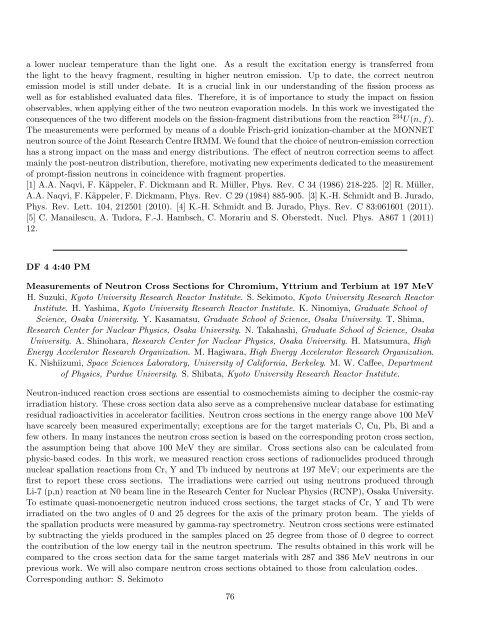Program - Brookhaven National Laboratory
Program - Brookhaven National Laboratory
Program - Brookhaven National Laboratory
Create successful ePaper yourself
Turn your PDF publications into a flip-book with our unique Google optimized e-Paper software.
a lower nuclear temperature than the light one. As a result the excitation energy is transferred from<br />
the light to the heavy fragment, resulting in higher neutron emission. Up to date, the correct neutron<br />
emission model is still under debate. It is a crucial link in our understanding of the fission process as<br />
well as for established evaluated data files. Therefore, it is of importance to study the impact on fission<br />
observables, when applying either of the two neutron evaporation models. In this work we investigated the<br />
consequences of the two different models on the fission-fragment distributions from the reaction 234 U(n, f).<br />
The measurements were performed by means of a double Frisch-grid ionization-chamber at the MONNET<br />
neutron source of the Joint Research Centre IRMM. We found that the choice of neutron-emission correction<br />
has a strong impact on the mass and energy distributions. The effect of neutron correction seems to affect<br />
mainly the post-neutron distribution, therefore, motivating new experiments dedicated to the measurement<br />
of prompt-fission neutrons in coincidence with fragment properties.<br />
[1] A.A. Naqvi, F. Käppeler, F. Dickmann and R. Müller, Phys. Rev. C 34 (1986) 218-225. [2] R. Müller,<br />
A.A. Naqvi, F. Käppeler, F. Dickmann, Phys. Rev. C 29 (1984) 885-905. [3] K.-H. Schmidt and B. Jurado,<br />
Phys. Rev. Lett. 104, 212501 (2010). [4] K.-H. Schmidt and B. Jurado, Phys. Rev. C 83:061601 (2011).<br />
[5] C. Manailescu, A. Tudora, F.-J. Hambsch, C. Morariu and S. Oberstedt. Nucl. Phys. A867 1 (2011)<br />
12.<br />
DF 4 4:40 PM<br />
Measurements of Neutron Cross Sections for Chromium, Yttrium and Terbium at 197 MeV<br />
H. Suzuki, Kyoto University Research Reactor Institute. S. Sekimoto, Kyoto University Research Reactor<br />
Institute. H. Yashima, Kyoto University Research Reactor Institute. K. Ninomiya, Graduate School of<br />
Science, Osaka University. Y. Kasamatsu, Graduate School of Science, Osaka University. T. Shima,<br />
Research Center for Nuclear Physics, Osaka University. N. Takahashi, Graduate School of Science, Osaka<br />
University. A. Shinohara, Research Center for Nuclear Physics, Osaka University. H. Matsumura, High<br />
Energy Accelerator Research Organization. M. Hagiwara, High Energy Accelerator Research Organization.<br />
K. Nishiizumi, Space Sciences <strong>Laboratory</strong>, University of California, Berkeley. M. W. Caffee, Department<br />
of Physics, Purdue University. S. Shibata, Kyoto University Research Reactor Institute.<br />
Neutron-induced reaction cross sections are essential to cosmochemists aiming to decipher the cosmic-ray<br />
irradiation history. These cross section data also serve as a comprehensive nuclear database for estimating<br />
residual radioactivities in accelerator facilities. Neutron cross sections in the energy range above 100 MeV<br />
have scarcely been measured experimentally; exceptions are for the target materials C, Cu, Pb, Bi and a<br />
few others. In many instances the neutron cross section is based on the corresponding proton cross section,<br />
the assumption being that above 100 MeV they are similar. Cross sections also can be calculated from<br />
physic-based codes. In this work, we measured reaction cross sections of radionuclides produced through<br />
nuclear spallation reactions from Cr, Y and Tb induced by neutrons at 197 MeV; our experiments are the<br />
first to report these cross sections. The irradiations were carried out using neutrons produced through<br />
Li-7 (p,n) reaction at N0 beam line in the Research Center for Nuclear Physics (RCNP), Osaka University.<br />
To estimate quasi-monoenergetic neutron induced cross sections, the target stacks of Cr, Y and Tb were<br />
irradiated on the two angles of 0 and 25 degrees for the axis of the primary proton beam. The yields of<br />
the spallation products were measured by gamma-ray spectrometry. Neutron cross sections were estimated<br />
by subtracting the yields produced in the samples placed on 25 degree from those of 0 degree to correct<br />
the contribution of the low energy tail in the neutron spectrum. The results obtained in this work will be<br />
compared to the cross section data for the same target materials with 287 and 386 MeV neutrons in our<br />
previous work. We will also compare neutron cross sections obtained to those from calculation codes.<br />
Corresponding author: S. Sekimoto<br />
76
















